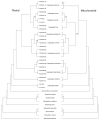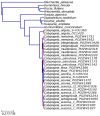Super-Mitobarcoding in Plant Species Identification? It Can Work! The Case of Leafy Liverworts Belonging to the Genus Calypogeia
- PMID: 36555212
- PMCID: PMC9779425
- DOI: 10.3390/ijms232415570
Super-Mitobarcoding in Plant Species Identification? It Can Work! The Case of Leafy Liverworts Belonging to the Genus Calypogeia
Abstract
Molecular identification of species is especially important where traditional taxonomic methods fail. The genus Calypogeia belongs to one of the tricky taxons. The simple morphology of these species and a tendency towards environmental plasticity make them complicated in identification. The finding of the universal single-locus DNA barcode in plants seems to be 'the Holy Grail'; therefore, researchers are increasingly looking for multiloci DNA barcodes or super-barcoding. Since the mitochondrial genome has low sequence variation in plants, species delimitation is usually based on the chloroplast genome. Unexpectedly, our research shows that super-mitobarcoding can also work! However, our outcomes showed that a single method of molecular species delimitation should be avoided. Moreover, it is recommended to interpret the results of molecular species delimitation alongside other types of evidence, such as ecology, population genetics or comparative morphology. Here, we also presented genetic data supporting the view that C. suecica is not a homogeneous species.
Keywords: Calypogeia; liverworts; mitogenome; species identification; super-barcoding.
Conflict of interest statement
The authors declare no conflict of interest.
Figures





Similar articles
-
Molecular delimitation of European leafy liverworts of the genus Calypogeia based on plastid super-barcodes.BMC Plant Biol. 2020 May 28;20(1):243. doi: 10.1186/s12870-020-02435-y. BMC Plant Biol. 2020. PMID: 32466772 Free PMC article.
-
Plant DNA barcoding: from gene to genome.Biol Rev Camb Philos Soc. 2015 Feb;90(1):157-66. doi: 10.1111/brv.12104. Epub 2014 Mar 26. Biol Rev Camb Philos Soc. 2015. PMID: 24666563 Review.
-
Does Calypogeia azurea (Calypogeiaceae, Marchantiophyta) occur outside Europe? Molecular and morphological evidence.PLoS One. 2018 Oct 10;13(10):e0204561. doi: 10.1371/journal.pone.0204561. eCollection 2018. PLoS One. 2018. PMID: 30304042 Free PMC article.
-
DNA barcoding of Cymbidium by genome skimming: Call for next-generation nuclear barcodes.Mol Ecol Resour. 2023 Feb;23(2):424-439. doi: 10.1111/1755-0998.13719. Epub 2022 Nov 4. Mol Ecol Resour. 2023. PMID: 36219539
-
Progress in the use of DNA barcodes in the identification and classification of medicinal plants.Ecotoxicol Environ Saf. 2021 Jan 15;208:111691. doi: 10.1016/j.ecoenv.2020.111691. Epub 2020 Nov 28. Ecotoxicol Environ Saf. 2021. PMID: 33396023 Review.
Cited by
-
Integrative approaches to a revision of the liverwort in genus Aneura (Aneuraceae, Marchantiophyta) from Thailand.PeerJ. 2023 Oct 24;11:e16284. doi: 10.7717/peerj.16284. eCollection 2023. PeerJ. 2023. PMID: 37901454 Free PMC article.
-
Decoding Evolution of Rubioideae: Plastomes Reveal Sweet Secrets of Codon Usage, Diagnostides, and Superbarcoding.Genes (Basel). 2024 Apr 27;15(5):562. doi: 10.3390/genes15050562. Genes (Basel). 2024. PMID: 38790191 Free PMC article.
-
Complete mitochondrial genome of Houttuynia cordata sheds light on the evolution of complex structural features in early angiosperms.BMC Plant Biol. 2025 Jun 7;25(1):774. doi: 10.1186/s12870-025-06801-6. BMC Plant Biol. 2025. PMID: 40483439 Free PMC article.
-
Reproductive and persistence strategy of the liverwort Arnellia fennica after the last glaciation in the area of disjunction in Central Europe (Polish Tatra Mountains, carpathians).Sci Rep. 2025 Jan 15;15(1):2030. doi: 10.1038/s41598-025-85757-x. Sci Rep. 2025. PMID: 39814918 Free PMC article.
-
The organellar genomes of Pellidae (Marchantiophyta): the evidence of cryptic speciation, conflicting phylogenies and extraordinary reduction of mitogenomes in simple thalloid liverwort lineage.Sci Rep. 2023 May 23;13(1):8303. doi: 10.1038/s41598-023-35269-3. Sci Rep. 2023. PMID: 37221210 Free PMC article.
References
-
- Fazekas A.J., Burgess K.S., Kesanakurti P.R., Graham S.W., Newmaster S.G., Husband B.C., Percy D.M., Hajibabaei M., Barrett S.C.H. Multiple multilocus DNA barcodes from the plastid genome discriminate plant species equally well. PLoS ONE. 2008;3:e2802. doi: 10.1371/journal.pone.0002802. - DOI - PMC - PubMed
MeSH terms
Substances
Grants and funding
LinkOut - more resources
Full Text Sources

